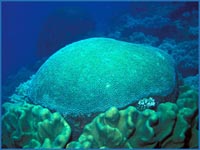Australian Brain Coral

Common Name: Australian Brain Coral
Scientific Name: Goniastrea Australensis
Description
Brain corals look like round boulders, some reaching quite large sizes. Like all corals, the Australian Brain Coral is a living animal belonging to a group known as the 'coelenterates' or jelly animals. The whole coral is a collective or colony made up of thousands of individual coral animals called polyps. Each polyp has a simple hollow body with a mouth in the centre surrounded by tentacles. The polyps make the coral skeleton by each secreting a wall and a floor of limestone (calcium carbonate) around the outside of its body. The Australian Brain Coral has its own distinctive pattern of ridges and valleys formed by rows of polyps that share the limestone walls. The colours vary, but it is most commonly green or brown, sometimes with different coloured valley floors from the walls..
Diet
The polyps feed on tiny animals and particles from the water around them. The growth of the coral colony is enhanced by the presence of tiny plant cells, which live in the coral tissues. These plants harvest energy from sunlight and pass back energy to the coral to assist in the coral skeleton construction.
Behaviour
Brain corals mainly feed at night by extending their tentacles which are armed with stinging darts called 'nematocysts'. During the day their tentacles are retracted into the corallite base. The nematocysts paralyse their prey, such as tiny shrimp, and then their tentacles wave the prey into the mouth cavity where the food is digested. When the food is absorbed into the polyp, some of the nutrients are passed to other polyps via the interconnecting living tissue. The polyp and interconnecting tissue build up a limestone base (the coral skeleton) by extracting calcium and carbonate ions from the seawater.
Life History
The polyps of the Brain Coral reproduce by releasing sperm and eggs into the water. These unite to form tiny round larvae called 'planulae'. Planulae, float in the water for a period of at least 5 days and those not eaten select a spot suitable for beginning a new colony. When a planula settles, it changes into a polyp, begins to secrete limestone and then begins to feed and grow by budding to form a new polyp. This process repeats itself many times resulting in the formation of a new Brain Coral colony.
Habitat
They are commonly found in shallow water such as intertidal reef flats or fringing reefs, rocky shorelines and harbour breakwaters.
Special Features or Habits
Brain corals help form the foundations of coral reefs. Many corals reproduce during spectacular mass spawning events that result in slicks of eggs and coral larvae on the surface of the ocean. This spawning only occurs over a few nights each year.
They are the toughest of all corals and can tolerate several hours of exposure to the tropical sun at low tide, silt and low salinity.
Location or Region Found
Found on both coasts of Australia and the western Pacific from Japan in the north to the Kermadec Islands in the south.
 Deep Sea Crabs
Deep Sea Crabs